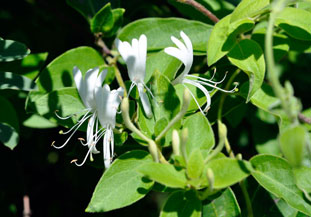JAPANESE HONEYSUCKLE
|
 |
| File Size: 78 KB |
|
|
|
Lonicera japonica Thunb.
|
| Wildcat Glades, Newton County, Missouri |
| Height: Vines to 32 feet |
| Family: Caprifoliaceae - Honeysuckle Family |
| Flowering Period: April, May, June |
|
| Trunks: | | Stems crawling or clambering; branches unarmed; often rooting adventitiously at nodes; bark yellowish brown to reddish brown, exfoliating in long strips; wood white, soft. | | Twigs: | | Reddish brown, flexible, smooth, pubescent; leaf scars crescent-shaped; pith white; buds reddish brown, ovoid, .04 inch, apex acute, scales pubescent. | | Leaves: | | Semipersistent, opposite, simple; petiole .08 to .43 inch, pubescent; blade ovate to oblong, 1.2 to 3.2 inches long, .6 to 1.2 inch wide, base wedge-shaped to rounded or truncate, margins entire, apex acute to obtuse, lower surfaces light green, pubescent at least along midvein, upper surfaces dark green, pubescent at least along midvein. | | Flowers: | | Inflorescences small, few-flowered cymes, axillary on new growth, 2 per node, each 2-flowered; peduncle .2 to .6 inch; pedicels absent. Flowers bisexual, bilaterally symmetric; hypanthium ovoid, .06 to .08 inch; sepals 5, connate, lobes .05 to .08 inch; petals 5, connate, corolla white, often turning yellowish white with age, 2-lipped, pubescent with glandular hairs, tube not gibbous at base, 1 to 1.1 inch, pubescent internally, abaxial lip 1-lobed, adaxial lip 4-lobed, lobes .24 to .3 inch; stamens 5, exserted; pistil 1, ovary inferior, 2-3-locular; style 1, 1.6 to 1.8 inches, pubescent; stigma capitate. | | Fruit: | | October-November; berries, black, globose to more or less ellipsoid, .2 to .3 inch diam., smooth, glabrous; seeds 4-10, brown to black, ovoid, .08 to .13 inch long, finely honeycombed, longitudinally 1-ridged. | | Habitat: | | Woodlands, forests, thickets, urban woodlots, roadsides, fencerows. | | Distribution: | | Principally east 1/3 of Kansas | | Origin: | | Naturalized | | Comments: | | Lonicera japonica is native to eastern Asia. It is an aggressive weed in parts of eastern Kansas, often clambering over shrubs and small trees. Japanese honeysuckle is legally noxious in four New England states. It affects native plants by outcompeting them for light, water, and nutrients. The flowers are sweet-scented and usually abundant, but the fruit set is low compared to the number of flowers produced (Stephens 1973). The leaves are semipersistent, with some remaining green through most or all of the winter. |
|
| Japanese honeysuckle flowers/stem |  | | 70 KB | | Wildcat Glades, Newton County, Missouri |
| | Japanese honeysuckle leaves |  | | 90 KB | | Wildcat Glades, Newton County, Missouri |
| | Japanese honeysuckle leaves |  | | 84 KB | | Wildcat Glades, Newton County, Missouri |
| | Japanese honeysuckle fruit |  | | 70 KB | | Eastern Kansas (photo by Craig Freeman) |
| | Japanese honeysuckle leaves |  | | 82 KB | | Wildcat Glades, Newton County, Missouri |
| | Japanese honeysuckle stem |  | | 51 KB | | Wildcat Glades, Newton County, Missouri |
| | Japanese honeysuckle twig pubescence |  | | 38 KB | | Wildcat Glades, Newton County, Missouri |
| | | |
|
|
|